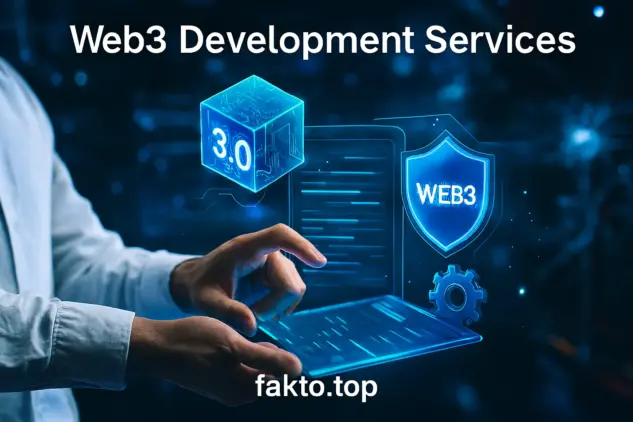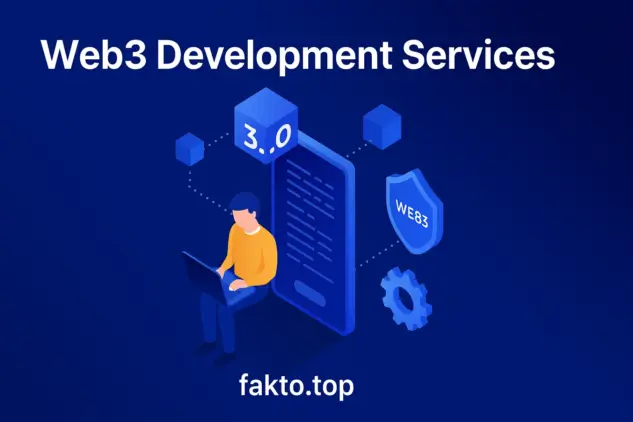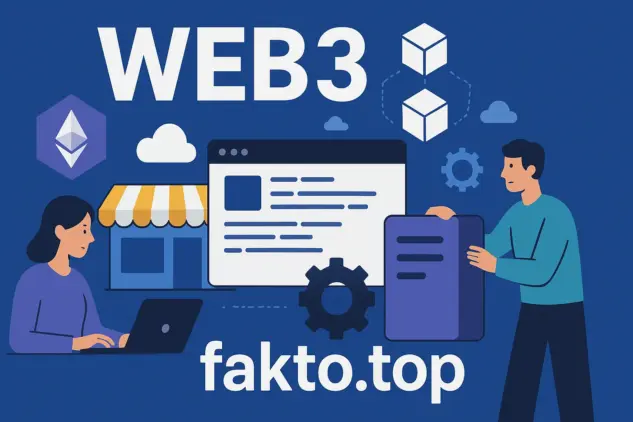Web3 Development Services: Practical B2B Guide to DeFi, NFT Utility & Growth
Web3 Development Services: Your Practical Guide to B2B Solutions and Growth Strategies
Web3 is not hype—it’s the new B2B infrastructure for trust. While Web2 centralized platforms built the foundation for digital interaction, they also created bottlenecks: data silos, rising platform fees, limited transparency, and dependence on third-party intermediaries. For business owners and enterprise leaders, this has meant limited control over customer relationships and restricted monetization models. Web3 development services now offer a practical way forward, creating verifiable, trust-based ecosystems where ownership, security, and automation drive measurable ROI.

Disclaimer: The information in this article is for educational and exploratory purposes only and does not constitute legal, financial, or investment advice. Implementations described here require project-specific security reviews, smart contract audits, and compliance checks with applicable laws and regulations in your jurisdiction. Past implementations or examples do not guarantee future results; always perform due diligence and consult qualified legal, tax, and security professionals before launching production Web3 systems.
The transition from Web2 to Web3 is more than a tech upgrade—it’s a business strategy. Traditional cloud systems still require trust in centralized entities, while blockchain-based solutions create systems where verification replaces trust. This shift allows businesses to automate agreements, manage digital assets securely, and scale operations globally without intermediaries. For B2B organizations, the message is clear: adopting Web3 means reducing friction, increasing transparency, and future-proofing your business model against evolving digital risks.
WEB3 smart contract audit: Security as Your Business Foundation
A web3 smart contract audit is the single most important investment before platform launch. In traditional IT, code reviews ensure performance. In blockchain ecosystems, audits guarantee survival. Every decentralized application (dApp) or tokenized platform relies on smart contracts that govern funds, permissions, and transactions automatically. A single overlooked bug can cost millions. That’s why serious B2B players treat auditing as a core stage of Web3 development—not a checkbox after deployment.
To understand the business logic behind audits, let’s look at the process. A professional Web3 auditor begins with architecture analysis—ensuring that smart contracts align with the company’s operational model. Then follows code-level review using both automated scanners and manual penetration testing. Reports include recommendations for smart contract optimization, gas efficiency improvements, and logical corrections. A clean audit does more than secure code—it builds investor and user confidence. When stakeholders know your dApp or protocol has passed an independent audit, they perceive your platform as stable and trustworthy.

For enterprise developers, the question isn’t “Do we need an audit?” but “How can we integrate it into our scaling strategy?” That’s where multi-chain infrastructure becomes relevant. Modern Web3 projects rarely operate on a single chain. Ethereum remains the foundation for complex financial logic, but many B2B teams expand to Polygon, Arbitrum, or Binance Smart Chain for scalability and cost efficiency. Multi-chain design introduces complexity—each environment may have unique security rules, token standards, and transaction models. A strong auditing partner helps harmonize this cross-chain logic, ensuring that contracts behave consistently across networks.
Ethereum dapp development: Choosing the Right Chain for B2B
When planning ethereum dapp development, businesses should consider not only technical feasibility but also strategic value. Ethereum’s mature ecosystem, extensive tooling, and proven security make it ideal for B2B pilots that demand reliability. However, cost per transaction (gas fees) can impact ROI, especially at scale. That’s why many developers combine Ethereum’s mainnet for settlement with sidechains for volume operations—a hybrid model maximizing both credibility and efficiency.
For instance, a B2B logistics company might deploy its core smart contracts on Ethereum for notarizing shipment data, while processing internal updates on Polygon for lower fees. This hybrid strategy leverages blockchain transparency without compromising operational flow. It also simplifies integration with third-party systems such as decentralized identity management tools and tokenized loyalty ecosystems. As a result, businesses can automate validation and build new trust-driven revenue channels.
In short, the Web3 foundation of trust begins with one principle—secure code equals sustainable growth. By prioritizing a smart contract audit early in development and leveraging multi-chain infrastructure strategically, B2B enterprises can transform blockchain security from a technical necessity into a core business differentiator. When done right, audits don’t slow you down—they accelerate market confidence and open the door to scalable, compliant Web3 B2B solutions built for long-term impact.
WEB3 onboarding: Simplifying User Access for Corporate Apps
Transitioning users from Web2 to Web3 presents a unique set of challenges. For B2B enterprises, web3 onboarding is more than a technical requirement—it is the gateway to adoption, retention, and revenue. Traditional Web2 login models rely on email and password combinations, which are familiar but inherently centralized and vulnerable. Web3 replaces these with wallet-based access, introducing a paradigm shift that demands thoughtful user experience (UX) design.

The first hurdle is the infamous “seed phrase” problem. Many users struggle to manage their private keys securely, leading to lost access or hesitation to engage with blockchain applications. To overcome this, enterprises implement account abstraction, a method that allows smart contracts to manage accounts in a more user-friendly way, reducing friction while maintaining security. Combined with wallet usability enhancements, such as guided setup flows and integrated recovery options, account abstraction ensures corporate users can onboard without frustration.
Another key strategy is leveraging dapp UX research to optimize workflows for corporate environments. This includes testing multiple onboarding flows, measuring completion rates, and iterating on design elements. A practical example is web3 onboarding for corporate training apps. Employees accessing tokenized training content need fast, seamless login and reward mechanisms. By integrating token-gated access and clear utility feedback, organizations can increase engagement and drive measurable outcomes.
| Feature | Web2 Login (Email/Password) | Web3 Login (Wallet / Account Abstraction) |
|---|---|---|
| Security | Centralized, vulnerable to breaches | Decentralized, user-controlled keys |
| Recovery | Password reset via email | Social recovery / smart contract-based |
| Usability | Familiar, easy for non-technical users | Requires onboarding guidance, but scalable |
| Integration | Single platform only | Works across multiple dapps and chains |
Beyond security, onboarding is the foundation of web3 retention models. Once users successfully access the system, tokenized loyalty and ongoing digital asset utility can create sustained engagement. For instance, employees might receive NFT-based achievements or loyalty tokens for completing training modules, which can then unlock additional resources or benefits. This approach ties back to the core B2B principle: onboarding is not a one-time event, it is the first step in a value-driven relationship.
Enterprise leaders should also consider decentralized identity solutions to streamline KYC/AML processes. This ensures compliance while maintaining user privacy, a critical factor for corporations operating across borders. By combining wallet usability improvements, account abstraction, and decentralized identity management, Web3 onboarding becomes a competitive advantage rather than a technical barrier.

In practice, companies that invest in intelligent onboarding see measurable gains: higher adoption rates, reduced support costs, and enhanced trust with corporate clients. A well-designed Web3 onboarding strategy transforms complex blockchain processes into intuitive workflows, enabling B2B enterprises to leverage the full potential of decentralized ecosystems for both internal operations and external client engagement.
Ultimately, Web3 onboarding is about making secure access frictionless. By prioritizing UX and integrating cutting-edge blockchain solutions, B2B organizations can convert skepticism into participation, turning early adopters into loyal stakeholders. The result is a scalable, secure, and user-friendly foundation for all subsequent Web3 initiatives, including tokenized loyalty programs, NFT utility applications, and multi-chain growth strategies.
Monetization & Utility: Practical B2B Web3 Use Cases
For B2B enterprises, the key to sustainable Web3 adoption lies in real-world utility. Your digital asset should provide ongoing value, not just a one-time sale. By leveraging nft utility design, token-gated access, and tokenized loyalty, businesses can create measurable ROI, improve retention, and unlock new monetization pathways. Let’s explore specific use cases that demonstrate practical applications of Web3 in corporate environments.
NFT utility for restaurant membership clubs
Restaurant chains and hospitality businesses can use NFTs to redefine loyalty programs. Instead of traditional punch cards or points systems, each NFT acts as a membership token granting exclusive perks—priority reservations, limited-edition menu items, or special event invitations. By integrating token gated access, restaurants can create tiered membership levels, ensuring that premium clients enjoy enhanced benefits. Tokenized loyalty not only encourages repeated engagement but also provides a transparent, verifiable ledger of rewards, reducing fraud and administrative overhead.

WEB 3 in real estate fractional ownership
In the real estate sector, fractional ownership enabled by blockchain opens new investment opportunities. Businesses can issue tokenized shares of commercial or residential properties, allowing multiple stakeholders to participate in ownership without traditional barriers. Each token can represent a proportionate stake, and smart contracts manage dividend distribution, voting rights, and transfer permissions. This use case highlights how multi-chain infrastructure can handle complex transactions securely while ensuring liquidity and compliance. Web3 fractional ownership transforms illiquid assets into programmable, tradable products, appealing to corporate investors seeking efficiency and transparency.
Tokenized brand ambassador loyalty programs
Corporate marketing departments can leverage tokenized loyalty for brand ambassadors and influencers. By issuing unique tokens as rewards for engagement—such as referrals, content creation, or social promotion—companies create an ecosystem where advocates receive tangible, tradable benefits. This approach aligns with blockchain for influencer monetization and community-led growth web3 strategies. Beyond financial incentives, tokenized programs provide valuable analytics: engagement data is recorded on-chain, allowing precise measurement of ambassador performance and program ROI.
Across these use cases, Web3 enables innovative retention models. Traditional loyalty schemes often rely on centralized tracking and opaque rules. In contrast, blockchain-based tokenized rewards are verifiable, automated, and programmable. Businesses can define reward curves, tier upgrades, or seasonal incentives, all encoded directly in smart contracts. When combined with nft utility design, tokens become more than collectibles—they are functional assets that drive ongoing engagement and business growth.
These implementations are also highly adaptable. Restaurant clubs, real estate platforms, and corporate loyalty programs can all incorporate web3 b2b solutions like decentralized identity verification, wallet interoperability, and account abstraction to reduce friction for participants. By combining practical utility with secure, automated systems, businesses transform digital assets into operational tools rather than speculative items.
In practice, successful B2B Web3 monetization emphasizes four principles: ongoing utility, transparent rules, scalable architecture, and measurable ROI. NFTs, tokenized loyalty, and token-gated access not only provide a direct revenue channel but also strengthen relationships with clients, partners, and employees. Each digital asset issued on-chain is an opportunity to deepen engagement and reinforce brand trust.
Ultimately, monetization in Web3 is inseparable from user experience. Enterprises that integrate these strategies carefully will see improved retention, enhanced operational efficiency, and new avenues for growth. The practical takeaway is clear: design digital assets for continuous value, secure them with audited smart contracts, and leverage multi-chain infrastructure to reach the broadest possible audience without compromising trust or compliance.
WEB3 marketing agency: New Strategies for Activation and Growth
Scaling a Web3 B2B platform requires more than technical implementation—it demands a strategic approach to market activation. Traditional Web2 marketing often relies on paid advertising, SEO, and email campaigns. In Web3, growth is increasingly driven by community engagement, tokenized incentives, and decentralized networks. Partnering with a web3 marketing agency enables enterprises to leverage these modern strategies effectively, aligning campaigns with web3 growth strategy principles and maximizing ROI.
One key focus is brand web3 activation. By integrating NFTs, tokenized loyalty, and token-gated experiences, companies can create compelling engagement loops. For example, a B2B software provider might issue NFT badges to early adopters of a new tool, granting access to premium features or exclusive workshops. This method encourages participation, builds community, and reinforces brand loyalty—all while tracking engagement transparently on-chain. These campaigns demonstrate that community-driven strategies can surpass traditional paid advertising in terms of cost efficiency and user retention.
Another powerful tactic is blockchain for influencer monetization. By tokenizing partnerships, companies can reward influencers based on measurable contributions, such as leads generated or content performance. Smart contracts automate payouts, ensuring transparency and trust. This model eliminates disputes over commissions and provides a scalable, data-driven approach to activating new audiences. B2B enterprises benefit from precise analytics, enabling them to adjust campaigns in real time and optimize community-led growth.
| Marketing Approach | Web2 | Web3 |
|---|---|---|
| Core Strategy | Paid Ads, SEO, Email Campaigns | Community-Led Growth, Token Incentives |
| Engagement | Click-throughs and impressions | Participation, ownership, loyalty |
| Measurement | Conversion rates, CTR | On-chain analytics, tokenized interactions |
| Cost Efficiency | High media spend | Lower cost per engagement, higher retention |
For enterprises, adopting these strategies involves integrating decentralized gaming asset marketplaces and tokenized reward systems into broader marketing efforts. Gamified engagement, combined with NFT ownership, encourages repeat interactions and deeper involvement in the brand ecosystem. Furthermore, integrating web3 retention models ensures that user participation is sustainable, not just a short-term spike.

Community-led growth also supports cross-functional initiatives, from corporate training apps to customer loyalty programs. By designing campaigns that reward participation and track interactions transparently, companies reduce reliance on centralized systems and create authentic, trust-driven engagement. This approach aligns perfectly with the principles established during onboarding and utility phases, creating a cohesive end-to-end Web3 experience for B2B clients.
Finally, a Web3 marketing agency ensures that these campaigns are not only technically viable but also strategically aligned with business goals. By combining expertise in tokenized incentives, NFT utility, and decentralized growth strategies, agencies guide enterprises through complex ecosystems. The result is a scalable, data-informed growth engine that enhances ROI, strengthens relationships with clients and partners, and positions the company as a forward-thinking leader in the Web3 B2B space.
Ultimately, successful Web3 activation is about harmonizing technical infrastructure with community engagement. By prioritizing strategic token utility, transparent incentives, and measurable results, B2B enterprises can transform marketing from a cost center into a growth engine. This completes the journey from secure smart contract foundations and frictionless onboarding to monetization and sustainable community-led activation.
Ready to discuss your custom Web3 development services strategy? Contact us today.
